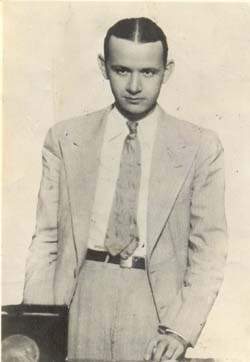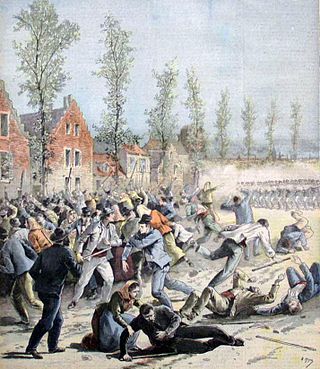
The Napoleonic Wars (1803–1815) were a series of conflicts fought between the First French Empire under Napoleon Bonaparte (1804–1815) and a fluctuating array of European coalitions. The wars originated in political forces arising from the French Revolution (1789–1799) and from the French Revolutionary Wars (1792–1802) and produced a period of French domination over Continental Europe. The wars are categorised as seven conflicts, five named after the coalitions that fought Napoleon, plus two named for their respective theatres: the War of the Third Coalition, War of the Fourth Coalition, War of the Fifth Coalition, War of the Sixth Coalition, War of the Seventh Coalition, the Peninsular War, and the French invasion of Russia.
A resistance movement is an organized group of people that tries to resist the government or an occupying power, causing disruption and unrest in civil order and stability. Such a movement may seek to achieve its goals through either the use of violent or nonviolent resistance, or the use of force, whether armed or unarmed. In many cases, as for example in the United States during the American Revolution, or in Norway in the Second World War, a resistance movement may employ both violent and non-violent methods, usually operating under different organizations and acting in different phases or geographical areas within a country.

Tactical frivolity is a form of public protest involving humour; often including peaceful non-compliance with authorities, carnival and whimsical antics. Humour has played a role in political protests at least as far back as the Classical period in ancient Greece. However, it is only since the 1990s that the term tactical frivolity gained common currency for describing the use of humour in opposing perceived political injustice. Generally, the term is used to denote a whimsical, nonconfrontational approach rather than aggressive mocking or cutting jokes.

A Pyrrhic victory is a victory that inflicts such a devastating toll on the victor that it is tantamount to defeat. Such a victory negates any true sense of achievement or damages long-term progress.

An invasion is a military offensive of combatants of one geopolitical entity, usually in large numbers, entering territory controlled by another similar entity, often involving acts of aggression. Generally, invasions have objectives of conquering, liberating or reestablishing control or authority over a territory; forcing the partition of a country; altering the established government or gaining concessions from said government; or a combination thereof. An invasion can be the cause of a war, be a part of a larger strategy to end a war, or it can constitute an entire war in itself. Due to the large scale of the operations associated with invasions, they are usually strategic in planning and execution. Not every military offense with the goal to capture territory or remove a government is an invasion.

The French Revolutionary Wars were a series of sweeping military conflicts resulting from the French Revolution that lasted from 1792 until 1802. They pitted France against Great Britain, Austria, Prussia, Russia, and several other countries. The wars are divided into two periods: the War of the First Coalition (1792–1797) and the War of the Second Coalition (1798–1802). Initially confined to Europe, the fighting gradually assumed a global dimension. After a decade of constant warfare and aggressive diplomacy, France had conquered territories in the Italian Peninsula, the Low Countries, and the Rhineland due to its very large and powerful military, which had been totally mobilized for war against most of Europe with mass conscription of the vast French population. French success in these conflicts ensured military occupation and the spread of revolutionary principles over much of Europe.
People's war or protracted people's war is a Maoist military strategy. First developed by the Chinese communist revolutionary leader Mao Zedong (1893–1976), the basic concept behind people's war is to maintain the support of the population and draw the enemy deep into the countryside where the population will bleed them dry through guerrilla warfare and eventually build up to mobile warfare. It was used by the Chinese communists against the Imperial Japanese Army in World War II, and by the Chinese Soviet Republic in the Chinese Civil War.

The 1999 Seattle WTO protests, sometimes referred to as the Battle of Seattle, were a series of anti-globalization protests surrounding the WTO Ministerial Conference of 1999, when members of the World Trade Organization (WTO) convened at the Washington State Convention and Trade Center in Seattle, Washington on November 30, 1999. The Conference was to be the launch of a new millennial round of trade negotiations.

The War of the Second Coalition was the second war targeting revolutionary France by many European monarchies, led by Britain, Austria, and Russia and including the Ottoman Empire, Portugal, Naples and various German monarchies. Prussia did not join the coalition, while Spain supported France.

Interesting Times is a fantasy novel by British writer Terry Pratchett. It is the seventeenth book in the Discworld series and is set in the Aurient.

The Taborites, known by their enemies as the Picards, were a faction within the Hussite movement in the medieval Lands of the Bohemian Crown.

The Red Terror was a campaign of political repression and executions in Soviet Russia carried out by the Bolsheviks, chiefly through the Cheka, the Bolshevik secret police. It officially started in early September 1918 and lasted until 1922. Arising after assassination attempts on Vladimir Lenin along with the successful assassinations of Petrograd Cheka leader Moisei Uritsky and party editor V. Volodarsky in alleged retaliation for Bolshevik mass repressions, the Red Terror was modeled on the Reign of Terror of the French Revolution, and sought to eliminate political dissent, opposition, and any other threat to Bolshevik power.

Antonio Guiteras y Holmes was a leading politician in Cuba during the 1930s.

Battle in Seattle is a 2007 political action-thriller film written and directed by Stuart Townsend, in his directorial debut. The story is loosely based on the protest activity at the WTO Ministerial Conference of 1999. The film had its world premiere at the Toronto International Film Festival on September 8, 2007. It later screened at the Seattle International Film Festival in May 2008 and received a limited theatrical release on September 19, 2008.

Pyotr Nikitich Tkachev was a Russian writer, critic and revolutionary theorist who formulated many of the revolutionary principles that were later developed and put into action by Vladimir Lenin. Although Tkachev is sometimes described as "the First Bolshevik", he did not figure prominently in the mythology of the Soviet Union.
Army of Shadows: Palestinian Collaboration with Zionism, 1917–1948 is a book published in 2004 by Hillel Cohen. It is about the sale of land and other co-operation between Arabs and Jews in Palestine before the establishment of the State of Israel.

A People's Tragedy: The Russian Revolution, 1891–1924 is a best-selling book by the British historian Orlando Figes on the Russian Revolution and the preceding quarter of a century. Written between 1989 and 1996, it was published in 1996 and re-issued with a new introduction for the revolution's centenary in 2017.

Direct action is a term for economic and political behavior in which participants use agency—for example economic or physical power—to achieve their goals. The aim of direct action is to either obstruct a certain practice or to solve perceived problems.
The Establishment, also known as military establishment, is a term used in Pakistan which refers to the deep state cooperation of the Pakistan Armed Forces, the Pakistani intelligence community, and other pro-military government officials and civilians. Responsible for various military coups, the military-dominated Establishment has directly ruled Pakistan for nearly half of its existence since its creation in 1947, while frequently exerting covert dominance over the political leadership during the remainder. The Establishment in Pakistan includes the key decision-makers in the country's military and intelligence services, national security, as well as its foreign and domestic policies, including the state policies of aggressive Islamization during the military dictatorship of General Muhammad Zia-ul-Haq.

Report on an Investigation of the Peasant Movement in Hunan or Inquiry into the Peasant Movement of Hunan of March 1927, often called the Hunan Report, is one of Mao Zedong's most famous and influential essays. The Report is based on a several month visit to his home countryside around Changsha, capital of Hunan in early 1927. The Report endorses the violence that had broken out spontaneously in the wake of the Northern Expedition, makes a class analysis of the struggle, and enthusiastically reports the "Fourteen Great Achievements" of the peasant associations (农民协会).
















